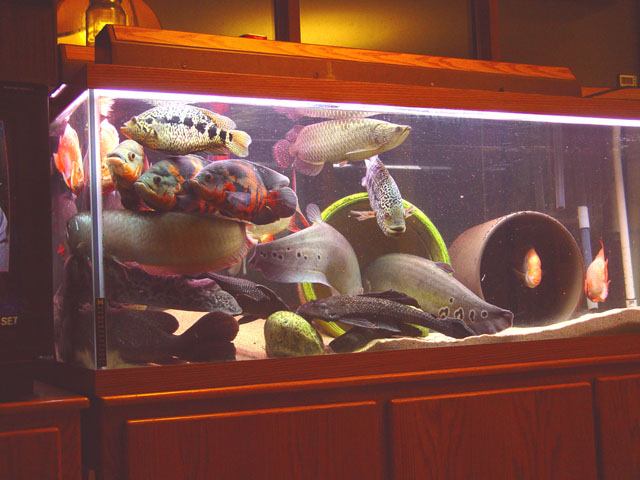Neon tetras, Swordtails, and Harlequin rasboras are surely a delight to watch and everyone loves them. But, for many aquarium hobbyists find these species tad too small to exhibit their aquarium skills. Which is why many of them prefer larger aquarium fishes like Discus, Oscars etc. to step up a notch. However, cultivating larger freshwater aquarium fishes in aquariums can be challenging and this article aims to provide our readers with some helpful tips to effectively aquascape an aquarium with bigger fishes in it. Read on to know more:
Selecting the Right Substrate: Substrate is undoubtedly the first thing that comes to your mind when you plan about beautifying your aquarium because apart from decorative purpose, the substrate is important for other reasons as well. The first and foremost being the fact that the substrate will help anchor most of the good bacteria, which is responsible for maintaining the nitrogen cycle in the tank. The substrate also serves as a rooting medium for live aquatic plants. For tanks with larger fishes in it, gravel and sand substrate works best, especially sand for fishes and feeders that sift through the sand to find food. For others about 2-inch deep gravel bed is ideal as it makes it easy to vacuum out the accumulated dirt on them.
Plants and Driftwoods:
Ornamenting an aquarium with live plants and driftwood is easy said than done especially with larger freshwater species like Oscar as they tend to be destructive in nature and engage in rearranging stuff inside the aquarium. They also tend to have the natural tendency of digging, thus disturbing the aesthetic beauty of your aquarium. For such larger fishes, ensuring decorative pieces that do not harm the fishes when bump into them like ones with sharp or rough edges. In short, it is always safe to avoid tank decorations with sharp edges. Driftwood is usually the safest bet among the tank decorations readily available in the market. Apart from imparting a natural look to your aquarium in the company of live plants, driftwood is helpful because it is light in weight and the fishes can easily move it without getting hurt.
Although driftwood is one of the ideal options for improving the aesthetic appeal of fish tanks, adopting few lifesaving hacks can help you make the most of driftwoods before you add them to your aquarium. If you do not like the idea of driftwoods being frequently moved around the tank by the fishes, consider attaching it to a piece of slate that you can sink to the bottom of the tank or immerse deep in your substrate. You also need to keep in mind that if the driftwood is not cured it might release tannins into the water, which might alter the pH levels of the aquarium water
Another noteworthy option to decorate your aquarium is usage of live plants. Though live aquarium plants are great for your aquarium due to their multifarious benefits, they do need the extra care and maintenance to thrive. Having live plants in your tank will add that extra zing to your tank apart from providing your fish with a healthy snack (for herbivores of course!). In addition, live plants will also help remove carbon dioxide from the water, while converting it into oxygen for your fish, and also control the growth of algae in the fish tank. But, it is not a hidden fact that aquarists have to devote time and money for the upkeep of live plants as they demand certain nutrients, special substrate and even a particular lighting intensity for optimum growth. It is of course up to you to decide whether you are comfortable doing that extra bit for the sake of your aquarium or not. If you are comfortable with the idea of decorating your tank with live plants, you should be careful about their placement in the tank. Taller plants are ideal as background plants hence plant it towards the rear end of the aquarium and shorter ones in front to leave ample space in the middle for the fishes to swim.
Always include hiding places:
Irrespective of the size of fish you add in your tank, including plenty of hiding places for them is absolutely indispensable. When you keep larger fishes in aquarium, accommodating a hiding place for them becomes a bit of a challenge. Cheaper options that are readily available at home like plastic or clay containers can be buried in the substrate and effectively serve the purpose. Other readily available and inexpensive options can be used from scrap materials like cut outs of PVC pipes, thick foliage of dense live plants used in aquarium or pieces of flat rocks positioned in a slanting manner on the tank wall. One must take into account that adding several hiding places scattered strategically inside the tank would be helpful because each fish gets a dedicated hiding place to itself. This smart move can significantly reduce aggression among fishes and increase their life span.
Suggestions for Reducing Aggression and Stress
It is true that all large species of fish are not disruptive by nature but they have a natural tendency to be more hostile than their smaller counterparts. It is challenging but not impossible to keep all aggressive species in one tank. The biggest hurdle will undoubtedly be creating and maintaining serene calmness inside your aquarium. Make sure that your tank is adequately roomy enough and has ample hiding places in order to segregate the tank into separate categories.
Look out for aggressive behavior symptoms like flaring of fins and gills, chasing other fishes or even nipping on fins of other fishes. You may address the problem accordingly once you notice any alarming behavior. Aquascaping with larger fishes is definitely challenging, but also rewarding at the same time. Planning, consistency, patience, and care are the ingredients of a skilled aquarist.
Please fill in the form get updates on new articles.


